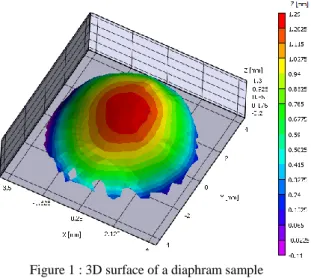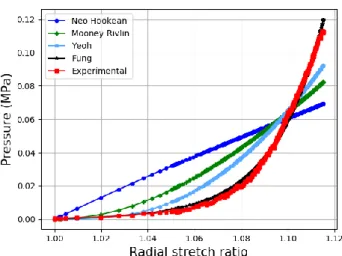HAL Id: hal-02087568
https://hal.archives-ouvertes.fr/hal-02087568
Submitted on 2 Apr 2019
HAL is a multi-disciplinary open access
archive for the deposit and dissemination of
sci-entific research documents, whether they are
pub-lished or not. The documents may come from
teaching and research institutions in France or
abroad, or from public or private research centers.
L’archive ouverte pluridisciplinaire HAL, est
destinée au dépôt et à la diffusion de documents
scientifiques de niveau recherche, publiés ou non,
émanant des établissements d’enseignement et de
recherche français ou étrangers, des laboratoires
publics ou privés.
Identification of porcine diaphragm non-linear behavior
via bulge tests
Jonaz Vasquez-Villegas, Rania Abdelrahman, Christiane Wagner-Kocher, S.
Lefloch, Nadia Bahlouli, Pascale Royer
To cite this version:
Jonaz Vasquez-Villegas, Rania Abdelrahman, Christiane Wagner-Kocher, S. Lefloch, Nadia Bahlouli,
et al.. Identification of porcine diaphragm non-linear behavior via bulge tests. European Society of
Biomechanics - ESB 2019, Jul 2019, Vienne, Austria. �hal-02087568�
IDENTIFICATION OF PORCINE DIAPHRAGM NON-LINEAR BEHAVIOR
VIA BULGE TESTS
Jonaz VASQUEZ-VILLEGAS (1), Rania ABDELRAHMAN (2), Christiane WAGNER-KOCHER (1) (3), Simon LE FLOC’H (1), Nadia BAHLOULI (4), Pascale ROYER (1)
1. LMGC Université de Montpellier, CNRS, France; 2. Université Française d’Egypte, Le Caire, Egypt; 3. LPMT, UHA, Mulhouse, France, 4. ICube, Université de Strasbourg, CNRS, France.
Introduction
Diaphragm is a dome shaped fibro-muscular structure which separates the thoracic and abdominal cavities. This delimitation is essential not only for the proper functioning of the surrounding organs but also for their development during pregnancy. Diaphragm is composed of a peripheral muscular part and a central tendon. In the current work, bulge tests were performed on a central tendon of porcine diaphragm. The mechanical behavior of the central tendon was obtained by using isotropic hyperelastic models.
The multiaxial tension generated by the bulge test [1] corresponds to the stresses induced in the diaphragm during respiratory motion.
Methods
A porcine diaphragm was dissected and frozen at -24°C for 1 week. N=10 discs of 30 mm were punched at different locations of the central tendon. Bulge tests with a controlled incremental pressure of 0.03 bar, together with the three-dimensional digital image correlation (3D-DIC) technique VIC 3D ©, provided a complete in-plane displacement distribution over the selected area of observation. The stretches distributions were estimated via a computational code implemented in Python using the experimental data. The materials parameters were identified by realizing the best fit between experimental data and the constitutive equations of the following isotropic models: Yeoh, Neo-Hookean, Mooney-Rivlin and Fung.
Figure 1 : 3D surface of a diaphram sample VIC 3D ©.
Results
It was concluded that the Yeoh, Neo-Hookean and Mooney-Rivlin models do not reproduce well the mechanical behavior of the central tendon of the diaphragm. This can be explained by the characteristic “toe-region” of soft tissues. An exponential constitutive model (Fung type [2] [3]) gave a better fit.
Figure 2: Example of inverse identification with 4 constitutive models
Discussion
The central tendon membrane of porcine clearly showed a non-linear behavior with a characteristic “toe-region”, similar to those obtained for many other soft tissue behaviors.
Our future work will focus on implementing the identification scheme using anisotropic hyperelastic behaviors. Indeed, the shape of the bulges identified through stereo-correlation (Figure 1) is more ellipsoidal than spherical, thus disproving the hypothesis of isotropic behavior.
References
1. Brunon A. et al, J Mech Behav Biomed Mater. 2011 Nov;4(8):1572-81. doi: 10.1016/j.jmbbm.2010.12.016.
2. Avril S. (2017) Hyperelasticity of Soft Tissues and Related Inverse Problems. In: Avril S., Evans S. (eds) Material Parameter Identification and Inverse Problems in Soft Tissue Biomechanics. CISM International Centre for Mechanical Sciences (Courses and Lectures), vol 573. Springer, Cham
3. Fung Y-C. Mechanical properties of Living Tissues, https://doi.org/10.1007/978-1-4757-2257-4
Acknowledgements
We thank Gille Camp, Jonathan Bares and Vincent Huon for their help in the experiments as well as the Association de Chasse

